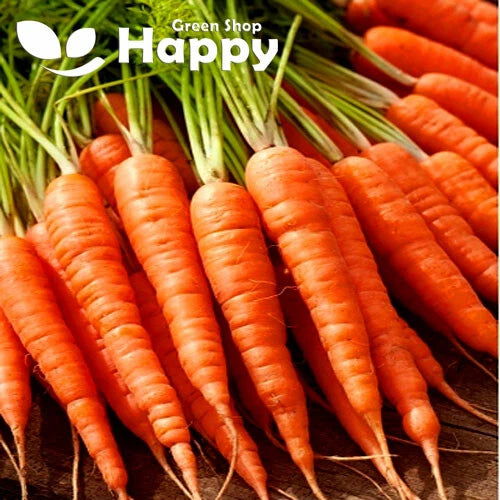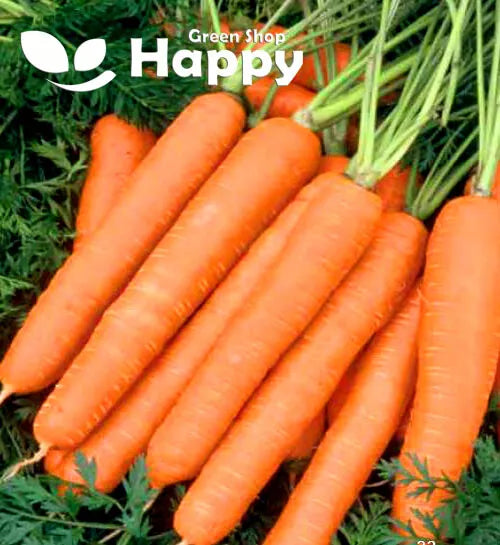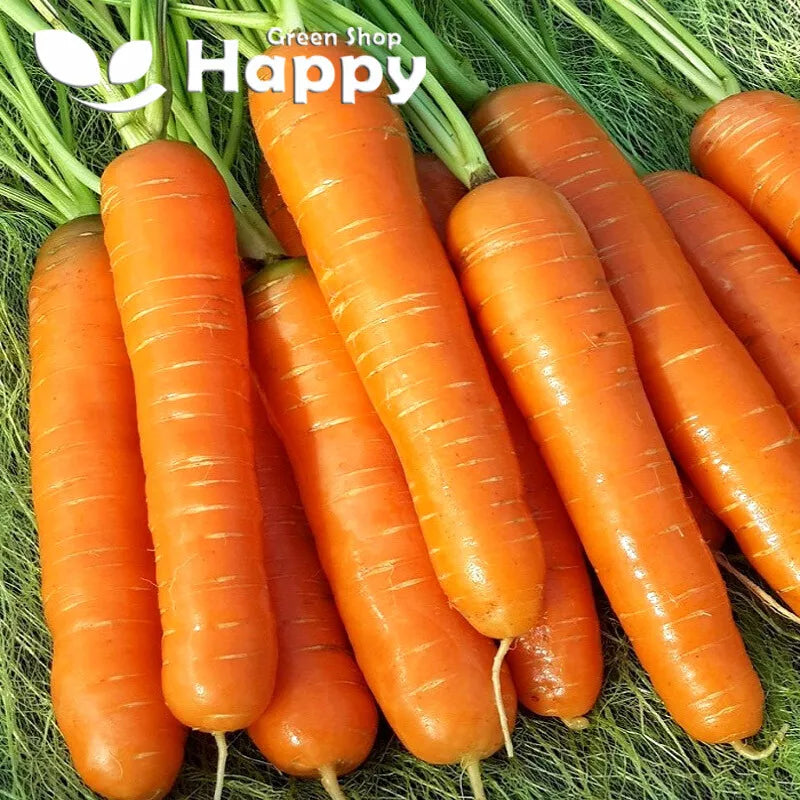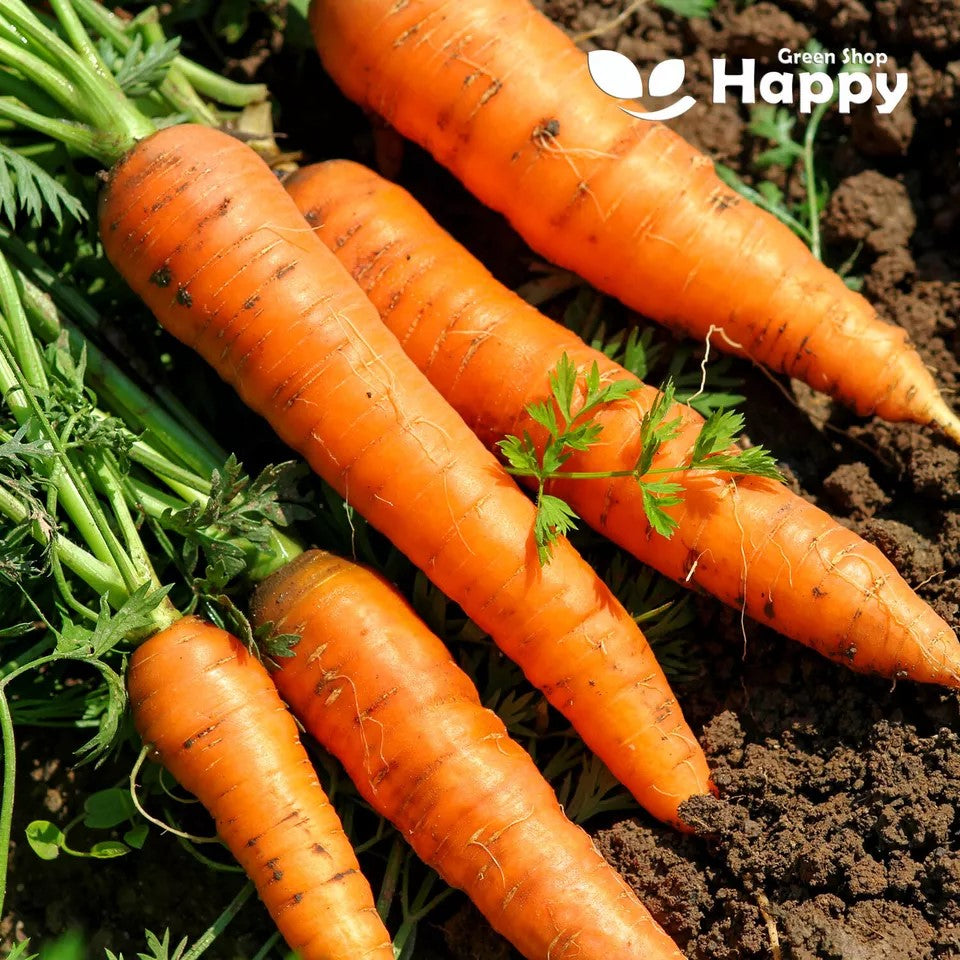Sort by:
34 products
34 products
Carrot ‘Paris Market’ Seeds (Daucus carota)
Grow charming, round carrots with Carrot ‘Paris Market’ (Daucus carota). This French heirloom variety produces small, globe-shaped roots with a sweet, crisp flavor, perfect for snacking, roasting, and adding to salads. Compact and fast-maturing, it thrives even in shallow or stony soils, making it an excellent choice for container growing and small gardens.
How to Grow
-
Sow seeds directly outdoors from early spring to midsummer.
-
Use well-drained, fertile soil in full sun.
-
Sow seeds 0.5–1 cm deep and thin seedlings to 3–5 cm apart.
-
Keep soil consistently moist for reliable germination (10–14 days).
-
Harvest roots when 3–5 cm in diameter for best flavor and texture.
Key Features
-
French heirloom with round, bite-sized carrots
-
Sweet, crisp flavor and smooth texture
-
Fast-maturing and compact growth habit
-
Grows well in shallow or stony soils
-
Perfect for containers, raised beds, and small gardens
Ideal For
-
Containers, raised beds, and small gardens
-
Fresh eating, roasting, and salads
-
Quick harvests and continuous sowing
-
Gardeners with less space or heavy soils
Sowing
-
Best time: Early spring to midsummer outdoors
-
Depth: 0.5–1 cm
-
Spacing: Thin to 3–5 cm apart
-
Prefers full sun and well-drained soil
Quick Tip
-
Sow in succession every 3 weeks for a steady supply of tender, bite-sized carrots all season long.
Carrot ‘Olympus’ Flakke Type Seeds (Daucus carota)
Grow sweet, crunchy carrots with Carrot ‘Olympus’ Flakke Type (Daucus carota). This early-maturing variety produces flat, broad, orange roots with excellent flavor, perfect for salads, cooking, and roasting. Easy to grow and reliable, it’s ideal for vegetable gardens, raised beds, and succession sowing.
How to Grow
-
Sow seeds directly outdoors from early spring to midsummer.
-
Use fertile, well-drained soil in full sun.
-
Sow seeds 1 cm deep and thin seedlings to 5–8 cm apart.
-
Keep soil consistently moist to support germination (10–14 days).
-
Harvest roots when they reach full size but remain tender.
Key Features
-
Flat, broad, sweet, and crunchy orange roots
-
Early-maturing and easy to grow
-
Ideal for salads, cooking, and roasting
-
Reliable and productive in temperate climates
-
Suitable for succession sowing for continuous harvest
Ideal For
-
Vegetable gardens and raised beds
-
Fresh salads, cooking, and roasting
-
Succession sowing for steady harvests
-
Kitchen gardens and allotments
Sowing
-
Best time: Early spring to midsummer outdoors
-
Depth: 1 cm
-
Spacing: Thin to 5–8 cm apart
-
Prefers full sun and fertile, well-drained soil
Quick Tip
-
Sow in successive batches every 2–3 weeks for a continuous supply of tender, sweet roots.
Carrot ‘Naomi’ Nantes Type Seeds (Daucus carota)
Enjoy sweet, tender carrots with Carrot ‘Naomi’ (Daucus carota), a classic Nantes type. This reliable variety produces uniform, cylindrical roots with smooth skin and excellent flavor, perfect for fresh eating, juicing, or cooking. Early-maturing and easy to grow, it’s an ideal choice for home gardens, raised beds, and allotments.
How to Grow
-
Sow seeds directly outdoors from early spring to midsummer.
-
Use fertile, stone-free, well-drained soil in full sun.
-
Sow seeds 1 cm deep in rows, spacing seedlings 5–8 cm apart.
-
Keep soil consistently moist for even germination (10–14 days).
-
Harvest roots when they reach 15–18 cm in length for best flavor and texture.
Key Features
-
Classic Nantes type with smooth, cylindrical roots
-
Sweet flavor and tender texture
-
Early-maturing and uniform growth
-
Excellent for fresh eating, juicing, and cooking
-
Reliable and easy to grow in most soils
Ideal For
-
Vegetable gardens, raised beds, and allotments
-
Fresh eating, juicing, cooking, and freezing
-
Continuous harvests with succession sowing
-
Gardeners of all levels
Sowing
-
Best time: Early spring to midsummer outdoors
-
Depth: 1 cm
-
Spacing: Thin to 5–8 cm apart
-
Prefers full sun and fertile, well-drained soil
Quick Tip
-
Sow in succession every 3 weeks to enjoy a continuous supply of sweet, tender carrots.
Carrot 'Early Nantes 3' – Seeds (Daucus carota)
The classic Carrot 'Early Nantes 3' is a reliable, early-maturing variety producing smooth, cylindrical roots with a bright orange color and sweet, tender flesh. Known for its uniform shape and excellent flavor, it’s perfect for fresh eating, juicing, steaming, or roasting. A favorite among gardeners, this variety is easy to grow and ideal for successional sowing throughout the season.
How to Grow
-
Sow seeds outdoors from March to July.
-
Sow thinly, 1 cm deep, in finely prepared soil, in rows 20–30 cm apart.
-
Thin seedlings to 5–8 cm spacing for well-formed roots.
-
Prefers light, well-drained soil in full sun.
-
Keep soil moist to prevent splitting.
Key Features
-
Classic early Nantes variety
-
Smooth, uniform, cylindrical roots
-
Sweet, tender flesh with excellent flavor
-
Quick to mature and high-yielding
-
Great for successional sowing
Ideal For
-
Fresh eating and juicing
-
Steaming, roasting, or soups
-
Succession sowing for extended harvests
-
Kitchen gardens, raised beds, and allotments
Sowing & Harvest
-
Sow: March to July
-
Depth: 1 cm
-
Spacing: 5–8 cm between plants, 20–30 cm between rows
-
Harvest: June to October
Quick Tip
-
Sow little and often every 2–3 weeks for a continuous supply of tender carrots.
Carrot ‘Cortina’ F1 Seeds (Daucus carota)
Grow sweet, uniform carrots with Carrot ‘Cortina’ F1 (Daucus carota). This early-maturing hybrid produces smooth, tapered, bright orange roots with excellent flavor, perfect for fresh salads, cooking, and roasting. Hardy and highly productive, it’s ideal for vegetable gardens, raised beds, and succession sowing for a continuous harvest.
How to Grow
-
Sow seeds directly outdoors from early spring to midsummer.
-
Use fertile, well-drained soil in full sun.
-
Sow seeds 1 cm deep and thin seedlings to 5–8 cm apart.
-
Keep soil consistently moist for optimal germination (10–14 days).
-
Harvest roots when fully grown but still tender for best flavor.
Key Features
-
Smooth, tapered, bright orange roots
-
Early-maturing and high-yield F1 hybrid
-
Sweet and flavorful, ideal for salads, cooking, and roasting
-
Reliable and easy to grow
-
Suitable for succession sowing for continuous harvest
Ideal For
-
Vegetable gardens, raised beds, and allotments
-
Fresh salads, cooking, and roasting
-
Succession sowing for steady harvests
-
Homegrown culinary use
Sowing
-
Best time: Early spring to midsummer outdoors
-
Depth: 1 cm
-
Spacing: Thin to 5–8 cm apart
-
Prefers full sun and fertile, well-drained soil
Quick Tip
-
Sow in successive batches every 2–3 weeks for a continuous supply of sweet, tender carrots.
Carrot 'Amsterdam 2' – 1000 Seeds (Daucus carota)
Carrot 'Amsterdam 2' is a very early and reliable variety producing smooth, slender, and sweet roots. With tender flesh and excellent flavor, it is perfect for eating fresh, juicing, or cooking. A quick-growing carrot ideal for successional sowings to enjoy a steady harvest all summer long.
How to Grow
-
Sow outdoors: February – July in well-prepared, finely raked soil.
-
Sow thinly in rows 20–25 cm apart.
-
Thin seedlings to 5 cm spacing for best root size.
-
Prefers full sun and well-drained, sandy soil.
Key Features
-
Early, fast-maturing variety
-
Slender, smooth, and sweet roots
-
Excellent for fresh eating, juicing & cooking
-
Ideal for containers and smaller gardens
-
Suitable for successional sowing
Ideal For
-
Fresh snacking and salads
-
Juices and soups
-
Succession planting for continuous crops
Sowing & Harvest
-
Sow: February – July
-
Harvest: May – September
Quick Tip
Sow small batches every 2–3 weeks to ensure a continuous harvest of tender carrots throughout the season.
Arugula ‘Garden Rocket’ Seeds (Eruca sativa)
Bring a peppery kick to your kitchen garden with Arugula ‘Garden Rocket’ (Eruca sativa). This fast-growing leafy green produces tender, deeply lobed leaves with a zesty, mustard-like flavor that’s perfect for salads, sandwiches, pizzas, and pasta dishes. Easy to grow and quick to mature, rocket is a must-have for continuous fresh harvests all season long.
How to Grow
-
Sow seeds directly outdoors from spring through autumn.
-
Use fertile, well-drained soil in full sun or partial shade.
-
Sow seeds 0.5 cm deep in rows, spacing 10–15 cm apart.
-
Keep soil moist for steady growth.
-
Harvest young leaves within 3–5 weeks for the best flavor.
Key Features
-
Fast-growing leafy green with peppery flavor
-
Ready to harvest in just a few weeks
-
Perfect for salads, sandwiches, pizzas, and pasta
-
Easy to grow in beds, borders, or containers
-
Continuous cropping with succession sowing
Ideal For
-
Fresh kitchen use in salads and cooked dishes
-
Containers, raised beds, and garden borders
-
Quick, cut-and-come-again harvesting
-
Gardeners of all skill levels
Sowing
-
Best time: Spring to autumn outdoors
-
Depth: 0.5 cm
-
Spacing: 10–15 cm apart
-
Prefers sun or partial shade with well-drained soil
Quick Tip
-
Sow every 2–3 weeks for a steady supply of young, tender leaves.
Showing 34/34













